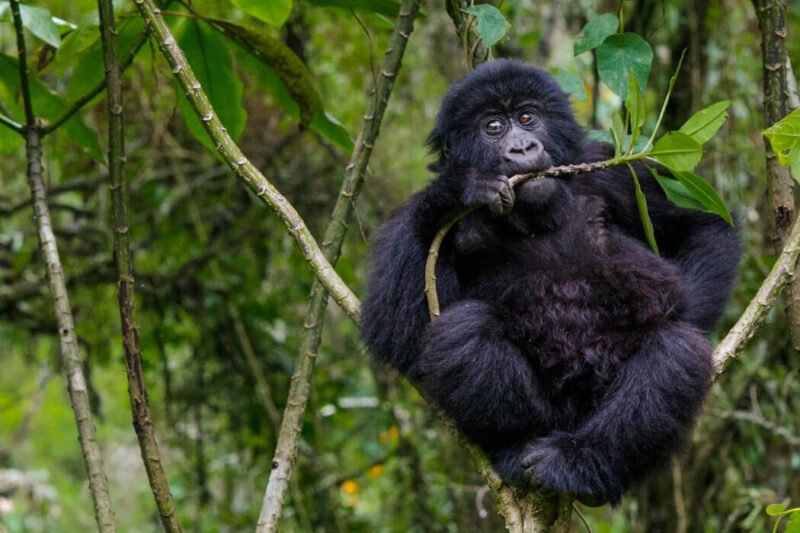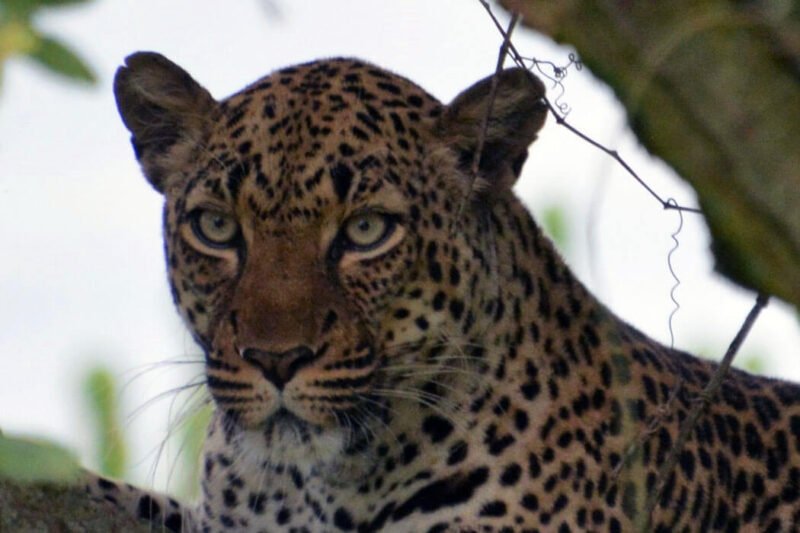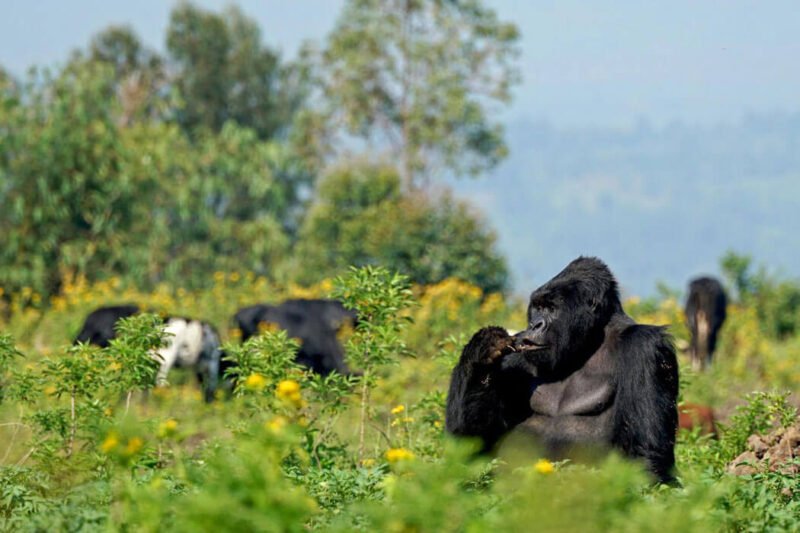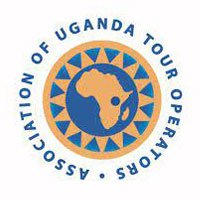Embark on a once-in-a-lifetime adventure with our gorilla safaris in Uganda and Rwanda. Seeing mountain gorillas in their natural habitat is not only an unforgettable experience but also a significant contributor to wildlife conservation.
With the largest population of mountain gorillas and competitive trekking rates, Uganda is the ideal destination for this awe-inspiring activity, complemented by Rwanda’s equally enchanting gorilla trekking in Volcanoes NP.
Our meticulously planned gorilla trekking safaris ensure you have all the information and support needed for a memorable journey. From understanding the costs involved to knowing what to pack and how to get there, we’ve got you covered.
Our experienced team customizes each trip to match your preferences, whether you seek a more challenging trek or a leisurely adventure.
Gorilla trekking isn’t just about the trek; it’s an immersive experience that includes learning about local cultures, exploring stunning landscapes, and encountering other wildlife. You can combine your gorilla trek with activities like wildlife safaris in nearby national parks, community visits, bird watching, and even white-water rafting on the Nile.
Book your gorilla safari with Exclusive African Safaris for an expertly guided, well-organized, and truly enriching gorilla experience.
Whether you’re trekking through the dense forests of Bwindi Impenetrable National Park or the bamboo-covered slopes of Mgahinga Gorilla National Park, we ensure a safe and rewarding experience, connecting you with one of the world’s most endangered and majestic creatures.
Gorilla Trekking Safaris
FAQs About Seeing Gorillas
Mountain gorillas are found only in Uganda, Rwanda, and the Democratic Republic of Congo.
In Uganda, you can see gorillas in Bwindi Impenetrable National Park and Mgahinga Gorilla National Park. Bwindi is home to about half of the world’s mountain gorilla population and is renowned for its rich biodiversity. Mgahinga, though smaller, also offers a rewarding trekking experience.
In Rwanda, gorilla trekking takes place in Volcanoes National Park, where you can enjoy the picturesque scenery of the Virunga Mountains.
Due to security concerns, we do not currently offer treks in the Democratic Republic of Congo.
All our gorilla safaris go to Uganda or Rwanda, with some trips having a double experience of seeing gorillas in both countries.
The cost of gorilla trekking involves several components.
A gorilla trekking permit, which is mandatory, costs $800 in Uganda and $1,500 in Rwanda. The cost of gorilla permit directly goes toward the conservation efforts for gorillas and their habitat.
Other expenses include transportation to and from the parks, which can vary based on whether you choose to fly or drive, and accommodation, which ranges from budget lodges to luxury resorts. Additional costs might include meals, tips, and optional activities. We provide comprehensive packages that cover all these aspects, ensuring a seamless experience.
Depending on the specifics of your safari, the cost can be optimized to give you a great experience on a budget – without compromising the quality. Reach out to us about planning your custom gorilla safaris based around your budget.
Most gorilla trekking safaris start from Entebbe and Kampala in Uganda, or Kigali in Rwanda.
If you’re in Uganda, you can either drive or take a domestic flight to Bwindi or Mgahinga. Driving offers a scenic view of the countryside but takes about 9 hours from Kampala. Domestic flights significantly reduce travel time.
From Kigali, a drive to Bwindi takes about 4-5 hours. We arrange all transportation logistics to ensure a comfortable journey to your trekking destination.
There are plenty of accommodation options near gorilla trekking sites, and they range from budget to luxury alternatives.
Budget accommodations provide basic amenities and are often closer to local communities. Mid-range lodges offer more comfort with amenities like hot showers and better meal options. Luxury lodges provide top-notch services, including gourmet meals, en-suite bathrooms, and stunning views of the surrounding landscapes from your bed.
Our recommendation and choice of lodges is base on our prior experience using them for ourselves and our guests.Depending on your budget and preferences, you will have a pleasant stay on your way to see the gorillas.
While everything regarding your trip will already be paid for and awaiting you, we recommend you carry some extra money for personal expenses. Tips to guides, porters and other service people are the most common use of this safari pocket money.
You might also want to buy souvenirs from local markets or craftspeople. Additionally, having cash on hand can be useful for any incidental expenses not covered by your safari package, such as extra snacks or drinks, or special activities you decide to add on the spot.
Take a look at our article about carrying safari pocket money, and dig into a bit more detail and our insight on the matter.
To take part in gorilla trekking, you must be at least 15 years old. This age limit helps ensure that participants are physically capable of handling the strenuous hike and understand the importance of following rules to protect the gorillas.
Participants should also be in good health, as trekking involves navigating through dense forests and steep terrains. If you have any contagious illnesses, like the flu, you will not be allowed to trek, as gorillas can catch human diseases.
As long as the above restrictions are not stopping you, you are eligible to do gorilla trekking and enjoy your personal encounter with a family of gorillas int he wild.
Properly packing for your gorilla trek will guaranteed that your experience is fulfilling and truly engaging.
Wear long-sleeved shirts and long pants to protect against insects and thorny plants. A light rain jacket is necessary due to the unpredictable rainforest weather. Sturdy hiking boots with good traction are essential for navigating the rough terrain.
Don’t forget sunscreen, a hat, and sunglasses to protect against the sun. Pack personal medications, a refillable water bottle, and energy snacks.
Carry your camera and phone for that selfie with gorillas, and the many pictures you will need to take of the entire experience.
For a detailed list, refer to our recommended packing guide for gorilla trekking.
Yes, you can enhance your gorilla trekking safari with various other activities.This is what most of the visitors to Uganda and Rwanda do, because why not?
Wildlife safaris in nearby parks like Queen Elizabeth and Lake Mburo allow you to see a wide range of animals, including elephants, lions, hippos, and zebras.
Community visits to the Batwa pygmies provide cultural insights and support local conservation efforts. For the adventurous, white-water rafting on the Nile in Jinja offers an exhilarating experience.
As you talk with us and we start planning your gorilla safari, all these and more can be added for you. It is all about you having the best experience in Uganda or Rwanda.
And if you can’t add all the things, you can always visit again, and each time, you will love Africa more and more. it is unavoidable.
The best time for gorilla trekking is during the dry seasons – June to September and December to February.
During these months, the trails are less muddy, making the hike a bit more manageable. The weather is also more predictable, with fewer chances of heavy rain.
However, gorilla trekking is possible year-round, and the wet seasons (March to May and October to November) offer the advantage of fewer crowds and lush, green landscapes.
Here is our full article that explores the best time to visit Uganda for gorillas, wildlife and other popular activities.
Gorilla trekking permits can be secured through us as part of your safari package, ensuring a hassle-free experience.
Alternatively, you can purchase permits directly from the Uganda Wildlife Authority or the Rwanda Development Board.
It’s important to book well in advance – at least 3 to 6 months ahead – due to high demand and limited availability. Each permit is specific to a date and sector, so planning your travel dates early is crucial.
For all our guests, we handle all these details and logistics to make sure that once your safari starts, all you have to do is make sure you are enjoying every little moment of your safari with Exclusive African Safaris.
Gorilla trekking can be physically demanding, involving several hours of hiking through dense forests and steep, uneven terrain. A moderate to high level of fitness is recommended.
Regular walking or hiking in preparation can help improve your endurance. If you have concerns about your fitness level, consult with your doctor before the trip. The rangers will also provide support and adjust the pace to ensure everyone’s safety and enjoyment.
People with disabilities can hire local porters to carry them on a hand-held stretcher (forest taxi) so that they can get as close to the gorillas as possible.
For people who have mobility troubles, do inform us ahead of time so that you are assigned to a gorilla family that will be close to the edge of the forest.
To protect the gorillas and ensure a safe experience, several rules must be followed. Here is a summary of what you should have in mind.
During the morning briefing before you go to see the gorillas, the park rangers will go over these rules and regulations and explain them for everyone clarity.
- Maintain a distance of at least 7 meters from the gorillas.
- Avoid eating, drinking, or smoking near them.
- Speak in a low voice and avoid sudden movements.
- Do not trek if you are ill, as gorillas can contract human diseases.
- Follow the guide’s instructions at all times.
These rules help minimize stress on the gorillas and reduce the risk of disease transmission.
On your gorilla safari, you are supposed to keep a distance of around 7 meters from the gorillas and not make sudden movements. From this distance you will observe them feed, play and interact with each other.
Photography is allowed but you have to turn your flash off as it can scare them.
Keeping a distance and not disturbing their environment ensures that the gorillas remain comfortable and unafraid of humans.
While you are not allowed to touch them, sometimes a gorilla will come closer than the 7 meters (because what are rules to a gorilla in the wild?), and in such lucky instances you should stay calm. Sometimes, the young ones will come and tag and your leg or shoes before going on, they are all just so peaceful and you needn’t panic – rather enjoy the rare interaction.
A gorilla trek can last anywhere from 2 to 6 hours, depending on the location of the gorillas.
You’ll traverse through dense vegetation, cross streams, and climb steep slopes. The journey is often challenging but rewarding, as you’ll encounter a variety of flora and fauna along the way.
Your ranger-guides will provide insights into the forest ecosystem and the habits of the gorillas. Upon reaching the gorillas, you’ll spend about an hour observing them, a moment that many describe as unforgettable.
There is no special requirement other than taking basic health and safety precautions.
If you are on regular medication, carry it for your trip. Wear insect repellent to protect against bites, and have a hat and sunscreen to protect again the sun.
Stay hydrated, follow your guide’s instructions and inform your guide in case of any uneasiness due to the altitude, the pace of movement or anything else.
Yes, you can take photographs, but avoid using flash as it can startle the gorillas.
Bring extra batteries and memory cards, as you’ll be away from any charging facilities. Waterproof cases or bags for your camera equipment are advisable, given the unpredictable weather of the rain forest.
Take advantage of your guide’s knowledge to capture the best shots without disturbing the gorillas.
Gorilla trekking groups are limited to a maximum of 8 people per gorilla family.
This limit helps reduce stress on the gorillas and ensures a more intimate and controlled experience for trekkers. Smaller group sizes also allow for better management of the trek and enhance the overall experience, as guides can provide more personalized attention.
Mountain gorillas are found only in Uganda, Rwanda, and the Democratic Republic of Congo.
In Uganda, you can see gorillas in Bwindi Impenetrable National Park and Mgahinga Gorilla National Park. Bwindi is home to about half of the world’s mountain gorilla population and is renowned for its rich biodiversity. Mgahinga, though smaller, also offers a rewarding trekking experience.
In Rwanda, gorilla trekking takes place in Volcanoes National Park, where you can enjoy the picturesque scenery of the Virunga Mountains.
Due to security concerns, we do not currently offer treks in the Democratic Republic of Congo.
All our gorilla safaris go to Uganda or Rwanda, with some trips having a double experience of seeing gorillas in both countries.
The cost of gorilla trekking involves several components.
A gorilla trekking permit, which is mandatory, costs $800 in Uganda and $1,500 in Rwanda. The cost of gorilla permit directly goes toward the conservation efforts for gorillas and their habitat.
Other expenses include transportation to and from the parks, which can vary based on whether you choose to fly or drive, and accommodation, which ranges from budget lodges to luxury resorts. Additional costs might include meals, tips, and optional activities. We provide comprehensive packages that cover all these aspects, ensuring a seamless experience.
Depending on the specifics of your safari, the cost can be optimized to give you a great experience on a budget – without compromising the quality. Reach out to us about planning your custom gorilla safaris based around your budget.
Most gorilla trekking safaris start from Entebbe and Kampala in Uganda, or Kigali in Rwanda.
If you’re in Uganda, you can either drive or take a domestic flight to Bwindi or Mgahinga. Driving offers a scenic view of the countryside but takes about 9 hours from Kampala. Domestic flights significantly reduce travel time.
From Kigali, a drive to Bwindi takes about 4-5 hours. We arrange all transportation logistics to ensure a comfortable journey to your trekking destination.
There are plenty of accommodation options near gorilla trekking sites, and they range from budget to luxury alternatives.
Budget accommodations provide basic amenities and are often closer to local communities. Mid-range lodges offer more comfort with amenities like hot showers and better meal options. Luxury lodges provide top-notch services, including gourmet meals, en-suite bathrooms, and stunning views of the surrounding landscapes from your bed.
Our recommendation and choice of lodges is base on our prior experience using them for ourselves and our guests.Depending on your budget and preferences, you will have a pleasant stay on your way to see the gorillas.
While everything regarding your trip will already be paid for and awaiting you, we recommend you carry some extra money for personal expenses. Tips to guides, porters and other service people are the most common use of this safari pocket money.
You might also want to buy souvenirs from local markets or craftspeople. Additionally, having cash on hand can be useful for any incidental expenses not covered by your safari package, such as extra snacks or drinks, or special activities you decide to add on the spot.
Take a look at our article about carrying safari pocket money, and dig into a bit more detail and our insight on the matter.
To take part in gorilla trekking, you must be at least 15 years old. This age limit helps ensure that participants are physically capable of handling the strenuous hike and understand the importance of following rules to protect the gorillas.
Participants should also be in good health, as trekking involves navigating through dense forests and steep terrains. If you have any contagious illnesses, like the flu, you will not be allowed to trek, as gorillas can catch human diseases.
As long as the above restrictions are not stopping you, you are eligible to do gorilla trekking and enjoy your personal encounter with a family of gorillas int he wild.
Properly packing for your gorilla trek will guaranteed that your experience is fulfilling and truly engaging.
Wear long-sleeved shirts and long pants to protect against insects and thorny plants. A light rain jacket is necessary due to the unpredictable rainforest weather. Sturdy hiking boots with good traction are essential for navigating the rough terrain.
Don’t forget sunscreen, a hat, and sunglasses to protect against the sun. Pack personal medications, a refillable water bottle, and energy snacks.
Carry your camera and phone for that selfie with gorillas, and the many pictures you will need to take of the entire experience.
For a detailed list, refer to our recommended packing guide for gorilla trekking.
Yes, you can enhance your gorilla trekking safari with various other activities.This is what most of the visitors to Uganda and Rwanda do, because why not?
Wildlife safaris in nearby parks like Queen Elizabeth and Lake Mburo allow you to see a wide range of animals, including elephants, lions, hippos, and zebras.
Community visits to the Batwa pygmies provide cultural insights and support local conservation efforts. For the adventurous, white-water rafting on the Nile in Jinja offers an exhilarating experience.
As you talk with us and we start planning your gorilla safari, all these and more can be added for you. It is all about you having the best experience in Uganda or Rwanda.
And if you can’t add all the things, you can always visit again, and each time, you will love Africa more and more. it is unavoidable.
The best time for gorilla trekking is during the dry seasons – June to September and December to February.
During these months, the trails are less muddy, making the hike a bit more manageable. The weather is also more predictable, with fewer chances of heavy rain.
However, gorilla trekking is possible year-round, and the wet seasons (March to May and October to November) offer the advantage of fewer crowds and lush, green landscapes.
Here is our full article that explores the best time to visit Uganda for gorillas, wildlife and other popular activities.
Gorilla trekking permits can be secured through us as part of your safari package, ensuring a hassle-free experience.
Alternatively, you can purchase permits directly from the Uganda Wildlife Authority or the Rwanda Development Board.
It’s important to book well in advance – at least 3 to 6 months ahead – due to high demand and limited availability. Each permit is specific to a date and sector, so planning your travel dates early is crucial.
For all our guests, we handle all these details and logistics to make sure that once your safari starts, all you have to do is make sure you are enjoying every little moment of your safari with Exclusive African Safaris.
Gorilla trekking can be physically demanding, involving several hours of hiking through dense forests and steep, uneven terrain. A moderate to high level of fitness is recommended.
Regular walking or hiking in preparation can help improve your endurance. If you have concerns about your fitness level, consult with your doctor before the trip. The rangers will also provide support and adjust the pace to ensure everyone’s safety and enjoyment.
People with disabilities can hire local porters to carry them on a hand-held stretcher (forest taxi) so that they can get as close to the gorillas as possible.
For people who have mobility troubles, do inform us ahead of time so that you are assigned to a gorilla family that will be close to the edge of the forest.
To protect the gorillas and ensure a safe experience, several rules must be followed. Here is a summary of what you should have in mind.
During the morning briefing before you go to see the gorillas, the park rangers will go over these rules and regulations and explain them for everyone clarity.
- Maintain a distance of at least 7 meters from the gorillas.
- Avoid eating, drinking, or smoking near them.
- Speak in a low voice and avoid sudden movements.
- Do not trek if you are ill, as gorillas can contract human diseases.
- Follow the guide’s instructions at all times.
These rules help minimize stress on the gorillas and reduce the risk of disease transmission.
On your gorilla safari, you are supposed to keep a distance of around 7 meters from the gorillas and not make sudden movements. From this distance you will observe them feed, play and interact with each other.
Photography is allowed but you have to turn your flash off as it can scare them.
Keeping a distance and not disturbing their environment ensures that the gorillas remain comfortable and unafraid of humans.
While you are not allowed to touch them, sometimes a gorilla will come closer than the 7 meters (because what are rules to a gorilla in the wild?), and in such lucky instances you should stay calm. Sometimes, the young ones will come and tag and your leg or shoes before going on, they are all just so peaceful and you needn’t panic – rather enjoy the rare interaction.
A gorilla trek can last anywhere from 2 to 6 hours, depending on the location of the gorillas.
You’ll traverse through dense vegetation, cross streams, and climb steep slopes. The journey is often challenging but rewarding, as you’ll encounter a variety of flora and fauna along the way.
Your ranger-guides will provide insights into the forest ecosystem and the habits of the gorillas. Upon reaching the gorillas, you’ll spend about an hour observing them, a moment that many describe as unforgettable.
There is no special requirement other than taking basic health and safety precautions.
If you are on regular medication, carry it for your trip. Wear insect repellent to protect against bites, and have a hat and sunscreen to protect again the sun.
Stay hydrated, follow your guide’s instructions and inform your guide in case of any uneasiness due to the altitude, the pace of movement or anything else.
Yes, you can take photographs, but avoid using flash as it can startle the gorillas.
Bring extra batteries and memory cards, as you’ll be away from any charging facilities. Waterproof cases or bags for your camera equipment are advisable, given the unpredictable weather of the rain forest.
Take advantage of your guide’s knowledge to capture the best shots without disturbing the gorillas.
Gorilla trekking groups are limited to a maximum of 8 people per gorilla family.
This limit helps reduce stress on the gorillas and ensures a more intimate and controlled experience for trekkers. Smaller group sizes also allow for better management of the trek and enhance the overall experience, as guides can provide more personalized attention.





























